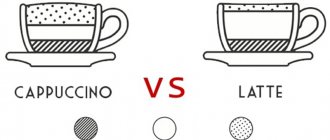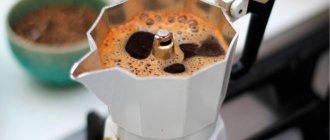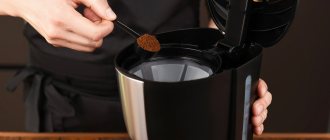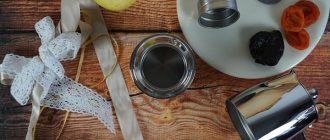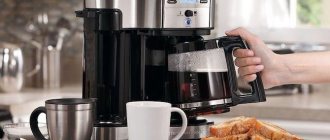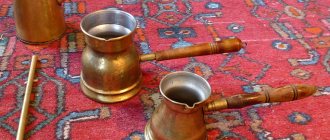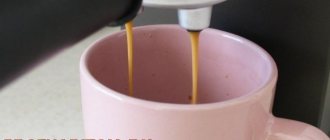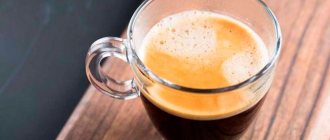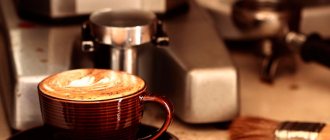Cappuccino is an excellent option for lovers of sweet coffee, as well as for people in whom black coffee causes a negative reaction in the body. A coffee drink made with milk with the addition of various ingredients (cinnamon, cognac) increases performance, gives strength, and strengthens the immune system. It is not difficult to prepare aromatic cappuccino at home, either in a Turk or a coffee maker, or in a coffee machine.
How to make an incredibly delicious cappuccino in a coffee maker
In the modern world, there are a lot of coffee lovers who want to enjoy it not only by visiting certain establishments, but also cook it at home. Agree, it’s much better to brew coffee at home and drink a warm drink with your whole friendly family, or to retire with your thoughts and think about the future.
In order to brew cappuccino in a coffee maker at home, you need to choose the type of coffee. To begin with, pay attention to the coffee and the roasting of the beans themselves. The best option would be a mixture of Robusta and Arabica with Italian roast. It is in this case that the coffee will have excellent consistency and strength.
Depending on the coffee maker, the grind of the coffee itself may vary. For example, for a French press it is better to choose a coarse grind, because small grains may end up in the coffee. It's not very tasty, and it doesn't look presentable.
A few words about choosing a blend
The flavor and aroma characteristics of the blend depend on the composition:
- 100% Arabica – rich soft taste, tandem of piquant sourness and sweetness;
- Arabica and Robusta blends are an ideal base for coffee and milkshakes due to the combination of sweetness and noble bitterness.
The higher the percentage of robusta, the more pronounced the shades of dark chocolate in the taste and aftertaste. The flavor and aroma bouquet depends on the degree of roasting of the grain.
Light roasting is usually used for elite beans, allowing the subtle and special properties of the beans to be revealed. Medium roast is universal and allows you to get the perfect balance of sweetness and sourness. Dark – for fans of strong drinks with a memorable taste.
Step-by-step whipping instructions
The whipping process consists of the following steps:
- Pour milk into the pitcher. The milk should be 1 cm less than the height of the beginning of the spout.
- Place the end of the cappuccino maker at an angle of 45° near the wall of the pitcher. It should point slightly away from the center of the milk jug. Depth up to 1 cm.
- When the end of the cappuccino maker is immersed in milk, you can turn on the machine to supply steam. The pitcher is usually held by the bottom to monitor the temperature of the milk.
- Hold the cappuccino maker so that the milk rotates in a whirlwind and a hiss is heard.
- The cappuccino maker is gradually lowered deeper to maintain the desired sound.
- Monitor the temperature of the bottom of the pitcher. If the bottom is warm, you need to proceed to the second phase.
- Place the nozzle lower until the hissing disappears, but the milk continues to rotate. Typically occurs 1 cm above the bottom of the pitcher.
- Warm until you can hold the pitcher by the handle without any problems. The temperature of the milk should not be higher than +75°.
- Turn off the steam supply and remove the nozzle from the milk.
- To ensure that the foam has a uniform consistency, you need to shake the pitcher with light movements and periodically tap the pitcher on the table.
How to make cappuccino in a carob coffee maker
To begin with, you need to pour ground coffee into a specific cone, and then tamp it down well. Next, pour water into an airtight container. Steam comes out of the horn into the coffee and as a result, you will get an incredible taste of coffee and a beautiful, dense foam.
When coffee is prepared, aromas and oils are released, thanks to which natural or instant coffee cappuccino acquires aroma, taste and richness. Today, carob coffee makers brew coffee with less caffeine and a wonderful aroma.
Design and principle of operation of a drip coffee maker
The design, tank volume, power, timer and other details of the coffee maker may differ, but the mechanism and operating principle of the device are the same for all models. The device is powered from the electrical network.
The basic package includes:
- power buttons;
- cold water tank;
- compartment for heating liquid (boiler);
- water supply pipes;
- heating element (TEN);
- coffee compartment (funnels);
- filter;
- container into which the finished product is poured.
After adding ground coffee, filling the compartment with cold water and turning it on, the heating process begins. When the temperature approaches the boiling point, the water rises through the tube and reaches the ground coffee compartment. The hot liquid is gradually filtered through crushed raw materials and a filter.
The finished drink drips into the final container. At the end of the water supply process, the device automatically turns off.
Types of filters
The filter is considered an important part of the coffee maker. It determines how fully the beneficial properties of ground coffee will be transferred to hot water.
Reusable
Many coffee machines come standard with reusable filters. The following products are mainly used:
- Metallic. Requires cleaning and washing after each use. The drink may contain fine thickeners and have an unpleasant metallic aftertaste.
- Nylon. It can be applied 60-80 times. It also needs to be washed after each use.
- "Gold". Indeed - nylon with titanium coating, which increases service life.
Due to the constant washing of reusable filters, many users prefer disposable items.
Disposable
Disposable filters do not require cleaning; they are simply removed along with the bottoms and thrown away. They are able to capture even the smallest particles. Paper filters are mainly used. They do not spoil the taste of coffee and are cheap. Bleached and unbleached paper and bamboo fibers are used for production.
Bleached products are treated with oxygen industrially. In the unbleached state, they are not processed in any way, so their distinctive feature is a brown tint.
Main advantages of paper filters:
- Eliminate foreign odors.
- Easy to Use: Easy to install and remove.
- They are also used to prepare the finest grind coffee.
- Eco-friendly, completely biodegradable.
- Unlike reusable ones, they prevent the development of bacteria.
Dimensions
The filter size must match the number of cups of coffee dispensed. Therefore, their parameters are designed for 1, 2, 4, 6, etc. Maximum – up to 12 servings. The dimensions are indicated on the packaging. They can be universal and are used in tritacapsules. Their sizes are the same for all brands of devices.
In more detail, all numbers are divided as follows:
- Numbers 1 and 2 refer to smaller coffee makers, which are rarely produced these days.
- Numbers 3 and 4 are the most common. Now when. 3 is combined with n. 4 and is not manufactured separately.
- Filters n. 6 and higher are intended for large coffee makers and coffee machines.
If the filter you need is not available, we recommend purchasing a larger size product. They fit well in their place, they just need to be trimmed a little on top.
Advantages and disadvantages of the device
Drip coffee makers have many benefits, which is why they are so widely used. The main advantages of this technique include the following:
- Affordable price. If we compare this technique with its other types, in terms of accessibility it is practically the first on the list. Carob and capsule types are much more expensive, and people can afford an IV even with a low income;
- Easy to use and maintain. The whole structure is quite simple to understand its structure. Therefore, it is just as easy to use. Just pour water, place the coffee filter and start the process;
- You can brew a lot of coffee. Unlike some coffee machines that can only brew 1-2 servings at a time, coffee makers can brew multiple servings at once, depending on their volume;
- Ability to maintain the temperature of the drink for some time. The automatic heating function will keep the drink fresh and hot for a long time. This feature is especially useful in offices where employees may drink coffee throughout the day;
- There is no thick sediment at the bottom of the finished drink;
- The device can prepare not only coffee, but also aromatic tea.
Drip coffee machines have more advantages than disadvantages
However, as usual, any device has its drawbacks. In a drip coffee maker they are as follows:
- Filters will have to be changed quite often when they become dirty. This is especially true for those templates that use paper versions.
- It will be necessary to wash the structure frequently after each use;
- Coffee is not always strong and hot. The consumption of coffee product is quite high. Therefore, gourmets who value elite varieties of cereals do not use this technique;
- It is not suitable for making espresso, since it will not have the delicate foam that is characteristic of the drink.
Possible failures
The most important thing in a cappuccino is the milk cap. But it does not always turn out dense and stable. There is no need to despair if you didn’t succeed in making cappuccino foam in a coffee machine the first time. You can increase the chances of proper cooking in different ways:
- It is worth experimenting with the fat content of the product. You can use full-fat (6%) milk – it whips easier. The calorie content of cappuccino will increase significantly, but the foam is guaranteed to be dense.
- Try milk from another manufacturer. In some stores you can find a product with a high protein content (3%) specifically for cappuccino, which is indicated on the packaging. True, the price is higher.
- Monitor the temperature of the milk to avoid overheating. Boiled food does not whip at all.
- Remove the milk from the refrigerator immediately before whipping or even place it in the freezer for a few minutes. The optimal temperature to start whipping is 2-4 °C. Cool the pitcher too.
Each coffee machine has its own “character”, you need to get used to it, practice several times, so that the cappuccino turns out no worse than that of real baristas.
Milk frothing equipment: cappuccino maker and pitcher
Before you begin the process of preparing a coffee drink, you need to prepare the equipment. To froth milk, the coffee machine must be equipped with a special tube that releases steam. The barista should also prepare a clean milk pitcher (jag).
Cappuccino maker
– devices for preparing milk foam used in espresso-based drinks.
The device must be connected to the steam wand on the coffee machine. Today there are a large number of devices of different shapes, dimensions, methods of supplying steam and functions performed. The most common attachment is the Panarello cappuccino maker. There are two types of cappuccino makers:
- steam
– spray principle; - mechanical
- the principle of torsion of the rims.
A pitcher is primarily a metal vessel for frothing milk. They can also be made of ceramics, plastic and glass. The material must have good thermal conductivity properties, since in order to froth milk, its temperature must be controlled. Also, the material must have a neutral chemical composition. A poor quality pitcher can greatly affect the taste of your coffee drink.
Several life hacks for coffee drink lovers
- Few people know that ground beans lose some of their aroma after half an hour. Essential oils found in grains usually oxidize when they come into contact with air, which is why all the aroma is lost. So you need to grind them immediately before preparing the drink.
- When making coffee, it is advisable to use filtered and bottled water. It is soft, with a slight sweetish taste.
- A little advice for those who are on a diet and trying to consume less sugar: you can add a little ground cinnamon to the drink. This spice will add a sweetish taste and a rather pleasant aroma to coffee.
Using coffee machines you can prepare many drinks, including cappuccino. To obtain a pleasant and delicate taste, you need to take into account some important points. If you follow the rules and preparation techniques, you will be able to enjoy a magnificent and exquisite cappuccino.
The most popular coffee recipes
There are many recipes for preparing this divine nectar.
Let's look at some of them:
Espresso
Espresso is the most popular strong coffee drink, obtained by passing water under pressure through a filter with powder.
Compound:
7–9 gr. pressed mass of southern Italian roasting Lavazza Suerte;
30 ml water.
To prepare a classic espresso you will need finely ground, highly roasted beans. Carob-type coffee makers are used at home. The crushed powder is poured into the holder (horn) and compacted with distemper. After 20-30 seconds, you get 30 ml of coffee drink with a reddish, dense foam.
Special cups made of thick demitas porcelain, 80 ml in volume, are pre-rinsed with hot water or steam and filled 2/3 with espresso. It is recommended to drink very slowly, prolonging the pleasure, savoring the aftertaste.
Latte
Compound:
1 tbsp. l. fine grind espresso coffee;
180–200 ml milk, pre-chilled;
2–3 gr. cinnamon or small nuts.
To prepare a latte in layers, take a tall Irish glass and pour 40–50 ml of freshly brewed espresso into it. Use a coffee maker to froth the milk and carefully fill the glass, pouring it down the side. Decorate with milk foam, cinnamon and nuts.
Viennese cappuccino
Compound:
40–50 ml freshly prepared espresso;
100 ml hot chocolate;
3-4 dessert spoons of whipped cream.
To make cappuccino, you need to brew espresso in a coffee maker from ground coffee mixture of medium roast. Coffee is gradually added to boiled hot milk. Whipped cream is placed on top. Decorate with grated chocolate.
